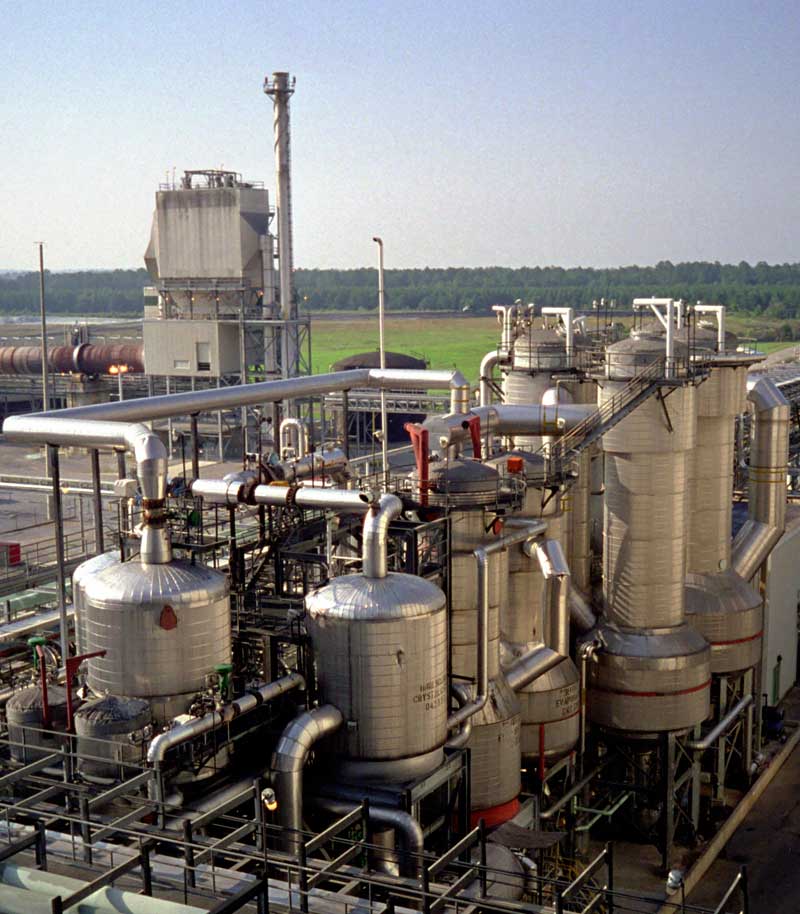Evaporators are used to separate materials based on differences in their boiling temperatures.
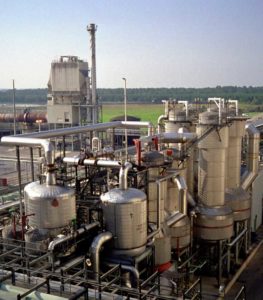
Long-Tube Vertical
Long tube, vertical evaporators are used for evaporation more than all other types combined because of the low cost per unit capacity.

Columbia, MD)
General Information
There are two main types of long-tube vertical evaporators: climbing-film and falling-film.
In both types feed enters the evaporators through tubes, is heated and part of it evaporates. The vapor is then recovered. In climbing film evaporators the liquid enters from the bottom, while in falling film types it enters from the top. The picture below shows a falling film evaporator.
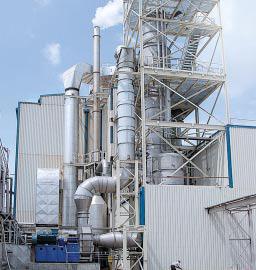
Equipment Design
In a climbing film, evaporator feed enters the evaporator through tubes in the bottom and is heated by surrounding steam. It climbs up the tubes as evaporation occurs. The liquid/vapor mixture continues up the tubes and is discharged into the vapor head. Liquid entrained in the vapor is separated by a deflector plate present above the tubes. The vapor exits out the top, while the liquor is either collected or allowed to fall back down the tubes, depending on the mode of operation.
In a falling film evaporator, feed enters from the top of the evaporator. It then flows down the inside walls of the tubes as a thin film. As the feed travels down the tube, evaporation occurs. The vapor/liquid mixture travels down the remaining tube length and into the vapor head. The vapor is removed through the top of the vapor head, while the liquid exits out the bottom.
The tubes in long-tube vertical evaporators are typically 2 in. in diameter and between 20 and 35 feet long. They may be operated in either batch or continuous modes.
One can distinguish between the two types of long-tube vertical evaporators by the location of the vapor head: The evaporator on the left is a climbing film evaporator, while the one on the right is a falling film.
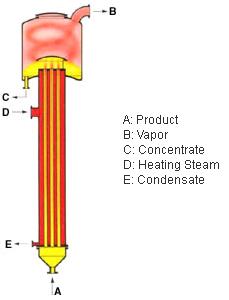
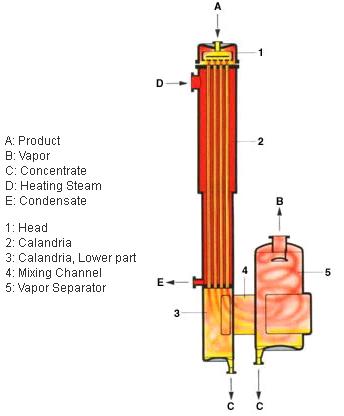
(Copyright GEA Process Engineering Inc., Columbia, MD)
Evaporators may be also used in series to produce a more highly concentrated product. In the quintuple-effect evaporator system shown here, the vapor product from each effect is used to heat the feed to the next effect. The condensed vapor is collected in the distillate stream.
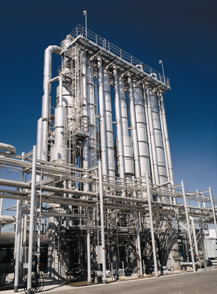
Usage Examples
Falling-film evaporators, such as those shown here, are used to concentrate heat-sensitive materials, such as fruit juices. Falling-film evaporators are also used when dealing with corrosive solutions or solutions that tend to foam.
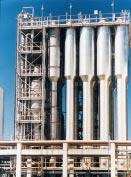
Columbia, MD)
Climbing-film evaporators are used heavily in the paper industry to concentrate black liquor. They are also used in the food industry to condense milk. The picture below shows a climbing film plate evaporator used in the food industry.
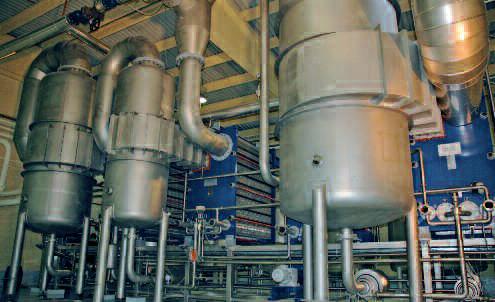
Advantages
- Low cost – cheapest evaporator per unit capacity
- Short downtime for cleaning
- Efficient heat transfer at reasonable temperature differences for climbing-film and at all temperature differences for falling-film evaporators
- Larger heating surface than other evaporators
Disadvantages
- Poor feed distribution
- Recirculation usually necessary in falling-film evaporators
- Unsuitable for salting and scaling liquids
- Inefficient heat transfer at low temperature differences for climbing-film evaporators
Short-Tube Vertical
Short tube vertical evaporators are the oldest type of evaporators in use today.
General Information
Short-tube vertical evaporators operate in the same way as climbing film long-tube vertical evaporators. Feed enters the evaporator and is heated. Vapor is recovered at the top, and the remaining liquor is collected at the bottom or recycled.
Equipment Design
In short-tube vertical evaporators, feed enters the evaporator from the bottom. It then rises through the tubes. As the feed is heated inside the tubes, evaporation takes place. The liquid/vapor mixture continues to rise up the remaining length of the tubes and into the vapor head. The vapor flows out the top of the vapor head, while the liquor falls back to the bottom of the evaporator, where it is combined with incoming feed.
The tubes inside a short-tube vertical evaporator are between 2 and 3 in. in diameter. These tubes are expanded into sheets that span the diameter of the evaporator.
The recycling rate within the evaporator is much greater than the feed rate. A downtake ensures that the liquid from the vapor head is recycled to the bottom of the evaporator in the minimum time.
Usage Examples
Short-tube vertical evaporators are used extensively in the evaporation of cane-sugar juice. They are also used in processes in which clear liquid solutions are present, or for non-corrosive conditions.
Advantages
- Efficient heat transfer at high-temperature differences
- Easy to descale
- Relatively inexpensive
Disadvantages
- Poor heat transfer at low-temperature differences or with viscous liquids
- Requires a great deal of floor space
- High holdup or residence time
Horizontal-Tube
Horizontal tube evaporators use a tube and spray method of heat transfer and differ in this respect from other evaporators.
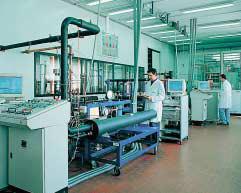
General Information
In horizontal-tube evaporators feed is sprayed over horizontal tubes that contain steam. As the feed flows over the tubes, evaporation takes place. The resulting vapor exits out the top of the evaporator, while the remaining liquor falls to the bottom of the evaporator and is either removed or recycled with the incoming feed.
Equipment Design
Liquor is circulated through a spray distribution network over the tube’s outside surface to ensure sufficient wetting of the heat transfer surface.
The tubes are arranged so as to maximize the heat transfer area between the steam and the liquor. This arrangement also facilitates cleaning because scaling and fouling are easily removed. The picture below is a schematic of a horizontal tube evaporator.
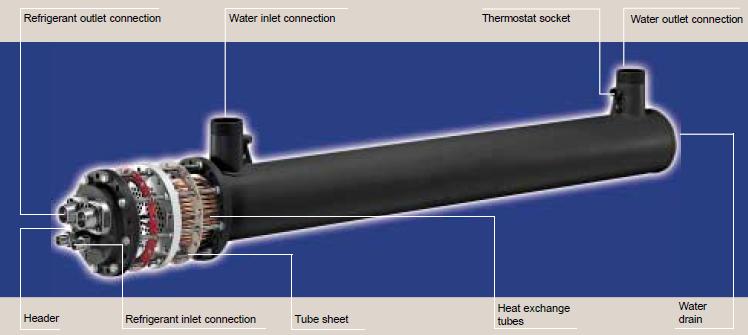
Usage Examples
One of the many uses of horizontal tube evaporators is the production of distilled water. Pure water is collected as vapor, while the wastewater is discharged directly from the system.
Horizontal tube evaporators are used frequently in the pulp and paper industry to concentrate solids into a slurry by evaporating off the water and other liquids. These evaporators are also used in the pharmaceutical industry to concentrate particular drugs or chemicals for medicinal use.
Advantages
- Larger liquid-vapor separation area than other evaporators
- Relatively low cost
- Very low headroom
Disadvantages
- Unsuitable for salting or scaling liquids
- Smaller capacity than other evaporators
- Liquid distribution is hard to maintain
Forced Circulation
Forced circulation evaporators contain a pump to circulate feed through the apparatus.
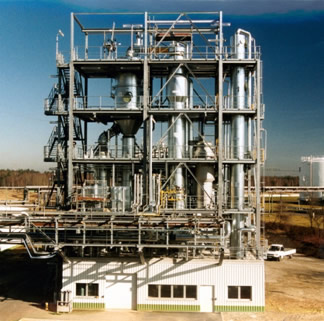
General Information
In forced circulation evaporators the feed is pumped into a heat exchanger, where evaporation occurs. The evaporated mixture then flows into the vapor head where any entrained liquid strikes the deflector plate. The vapor flows out the top of the vapor head, while the liquor is either removed or recycled.
Equipment Design
The most common type of forced circulation evaporator is the submerged-tube type. In these evaporators, the heating element is below the liquid level. This ensures that no boiling occurs in the tubes.
The heating elements may be oriented either vertically or horizontally, depending on the available headroom. In the diagram below, the heating elements are oriented horizontally.
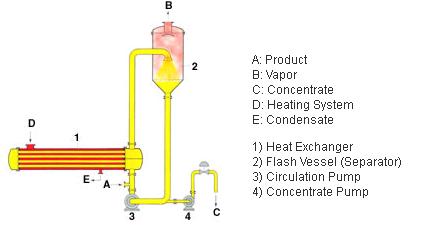
The use of a pump in forced circulation evaporators ensures continuous liquid flow rate. The pump also allows for the physical separation of the heat transfer and vapor-liquid separation components within the evaporator.
The liquid velocity through the evaporator is limited only by the pump. This is unlike other evaporators, where it is limited by other factors, such as the amount of evaporation.
Usage Examples
Forced circulation evaporators are used in the mining industry, where the solids are concentrated. The one shown below is involved in a brine concentration process.

Columbia, MD)
One of the main uses of forced circulation as well as other evaporators is in crystallization. They may also be used when corrosive or highly viscous solutions are to be evaporated.
Advantages
- Efficiently transfers heat from steam to liquid
- Continuous liquid flow
- Low amounts of salting, scaling and fouling
Disadvantages
- Expensive
- Power necessary for circulating pump
- Relatively high holdup or residence time
Agitated, Thin Film
General Information/Equipment Design
Agitated, thin-film evaporators, see thin-film dryers, use a heating surface composed of one tube of large diameter that may be either straight or tapered, horizontal or vertical. The liquid is spread on the tube wall by an agitator with rotating blades that cause the liquor to ride along the wall. See the Thin Film Dryers section for more details on this type of equipment.
Acknowledgements
- A.H. Lundberg Systems Limited, Vancouver, Canada
- Alfa Laval, Richmond, VA
- GEA Process Engineering Inc., Columbia, MD
References
- Boilers, Evaporators, and Condensers. New York: Wiley, 1991.
- McCabe, Warren L., Julian C. Smith, and Peter Harriott. Unit Operations of Chemical Engineering. 5th ed. New York: McGraw-Hill, 1993, 466-470.
- Perry, Robert H., and Don W. Green. Perry’s Chemical Engineers’ Handbook. 7th ed. New York: McGraw-Hill Inc., 1997, 11-13 – 11-18, 11-108 – 11-117
- Schweitzer, Philip A. Handbook of Separation Techniques for Chemical Engineers. 2nd ed. New York: Mc-Graw Hill Company, 1988: 2-132 – 2-133, 2-136.
- Yamamoto, Yoshiyuki. Design and Operation of Evaporators for Radioactive Wastes. Vienna: International Atomic Energy Agency, 1968.
Developers
- Sam Catalano
- Mark Colosimo
- Steve Wesorick
- Joseph Palazzolo
- Steve Cotton
- Thomas Plegue

